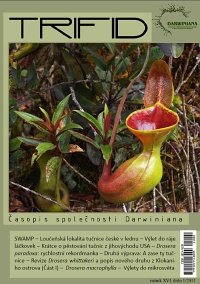Obsah
Trifid 2011/1
SWAMP
DH
This article presents information summary about one of the most widely known CP locality in Czech Republic. The locality which is placed in northern Bohemia close to Máchovo lake is preserved as a national natural monument. All Drosera species naturally growing in CR, bladderworts and many other interesting and mostly protected plants can be found in this locality. Besides plants the article is also describing some of the local animals and brings out general information about the peat-bog.
Loučeň: habitat of Pinguicula bohemica in January
Jakub Štěpán
The next locality of Pinguicula bohemica lies near Loučeň and was introduced to readers in one of the past Trifid journal. The locality is cared by volunteer brigade. The author points out possible consequences of some significant changes in the locality but mainly describes conditions on the locality during his inspection round.
Trip to Nepenthes paradise – Borneo 2009, part V
Václav Kubín
The fifth part of a report from trip to Borneo supplemented by several stunning pictures. This time you can learn what to expect on the tops of resident mountains (besides plenty of amazing pitcher plants). In the end of the article is sketched transfer to the highest mountain of Borneo which will be continued in the next issue.
Briefly about growing of Pinguiculas from south-eastern USA
Adam Veleba
Summary of growing knowledge of six American homophyllous Pinguicula species. The article sums up differences in growing requirements, points out possible risks and draws attention to easier growable species.
Donald E. Schnell: Carnivorous plants of the United States and Canada
Adam Veleba
Our librarian presents another CP book. This time it is an atlas of species which occur in North America. Many useful information about plants, their habitats and tips for growing can be found in.
Drosera paradoxa – the record breaker
Jiří Vaněk
This article came into being due to bad luck of the author. During repotting the author wrenched off roots of plant’s lateral shoot, so he decided to make the most of the situation and use leaves of the roots-free plant to its propagation. Thanks to ideal growing conditions he managed to get relatively big amount of young plants in very short time. You have the occasion to get know how to successfully propagate these Australian sundews.
Les Pleiades
Martin Dlouhý
Pokračování vyprávění z 2měsíční stáže ve Švýcarsku. Minulý díl nebyl tak úplně zaměřen na masožravé rostliny, v tomto tomu bude jinak. Autor se vydal na mokřady známé především díky přítomnosti uměle vysazených rostlin Sarracenia purpurea, kterým se na lokalitě daří a v současné době je rozhodně nepřehlédnete. Špirlice však nebyla jedinou nalezenou masožravkou. Kromě běžných rosnatek se po chvilce napínání pátračů ukázali také zástupci druhu Pinguicula vulgaris.
The second journey – the butterworts again, part II
Jarda Neubauer, Mirek Macák, Pepa Malínský
Report from hiking over French and Spanish CP-localities with dominant Pinguicula longifolia occurrence which can be really surprising plants in some cases. In this article you will learn what made the authors to make unplanned car-stop (surprisingly it was not a butterwort) and which endemic plant can be found in Pyrenees.
Revision of D. whittakeri s. lat. (Droseraceae) and description of new species from Kangaroo Island, South Australia – part I.
A. Lowrie, J. G. Conran
Czech translation of an article describing Drosera whittakeri and Drosera praefolia. Change of subspecies D. whittakeri subsp. aberrans to separate species is also mentioned. The endemic species D. schmutzii is described too.
Drosera macrophylla Lindley subsp. monantha
A. Lowrie, S Carlquist
Czech translation of the plant’s botanical description.
Excursion to micro world – part I
Martin Maloušek
This article opens a new pseudo-regular serial supplying interesting information from world invisible to the naked eye. In this first part the microscope is described and its capabilities are depicted on few CP pictures.
